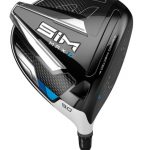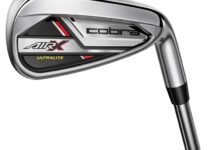Golfstead is reader-supported. When you buy through links on the site, we may earn an affiliate commission at no extra cost to you. Our affiliations include, but are not limited to, the eBay Partner Network and Amazon Associates.
In this review, I’ll take a close look at the TaylorMade SIM Max D driver.
The SIM Max D shares the same cutting-edge technologies that define the SIM family of drivers. But with a very large face, heel weight and divergent topline masking to encourage a draw ball flight, it’s the most forgiving SIM model that is aimed at high handicaps.
Just how much more forgiving is the SIM Max D than the SIM Max? How does it perform on the course? Is it worth putting in the bag?
Here’s what I’m going to be covering in this review:
- Ratings
- Features & Technologies
- Performance
- Look, Sound & Feel
- Where To Buy This Driver Online
- Conclusion
Read on to find out what you need to know to make an informed purchase.
Note: Unless otherwise stated, stock shafts and stock grips are used when evaluating this club. In most cases, the golf clubs reviewed on Golfstead are acquired temporarily for testing purposes and are not purchased. The review that follows is based on the personal experience and research of the author. Because everyone’s swing and body are different, results with a particular club may differ from person to person.
What are the reviews like?
The SIM Max D driver has excellent customer ratings — perhaps even slightly better than the SIM Max. In a way, this isn’t surprising, since a very large portion of TaylorMade’s customer base are high handicaps who need forgiveness.
It has a 5/5 rating on Global Golf and a 4.7/5 on the official TaylorMade website.
It has been given solid scores by professional critics and website reviewers. It earned a gold medal on the 2020 Golf Digest Hot List.
What People Like
- strong draw bias can outright eliminate a slice
- a very high MOI, a ton of launch, and extremely good mis-hit forgiveness
- large footprint inspires plenty of confidence at address
- relatively light and easy to swing
What People Don’t Like
- strong draw bias can produce bad results for some
- loud “thud” impact sound is unappealing to many
What are the features?
The SIM Max D has most of the same features as the SIM, namely:
- Speed-Injected Twist Face: a Twist Face that helps correct off-center hits is combined with injections that bring the speed of the face (COR) up to the legal limit.
- Asymmetric Shape: the unique design creates asymmetry and uses an Inertia Generator to shift weight back.
- Multi-Material Construction: allows weight to be positioned low and back in the head for less spin and higher MOI.
- Thru-Slot Speed Pocket: increases sole flexibility, leading to increased ball speed and forgiveness low on the face.
- Inverted Cone Technology: normally associated with TM irons, this expands the sweet spot on the face, leading to better mis-hit performance.
The key differences lie in the size, weighting, and adjustability.
First, the SIM Max D has an 18% larger face than the SIM. There’s no weight track, but there are two additions meant to introduce a rather strong draw bias, and thus help golfers avoid the right side (for a right-handed golfer) of the golf course:
- Heel Weight: an internal weight is strategically placed in the heel.
- Divergent Topline Masking: makes the driver look more open at address, encouraging golfers to turn the face over at impact.
Stock Info
The SIM Max D driver is available in 9°, 10.5°, and 12° standard lofts at 460CC, the same as the SIM Max.
It includes a loft sleeve that allows you to adjust loft, lie and face angle. There are 12 possible sleeve variations that can increase or decrease the loft and lie angle by ±2°, and the face angle by ±4°.
The stock shaft available with the SIM Max D is the UST Helium 5 (high launch). The stock grip is the Golf Pride Z-Grip.
If you’re interested, full information on the driver, shafts, grips, their specs, and any custom shaft options can be found here.
Below are the specs of the SIM Max D driver. Click or zoom to enlarge.
How does the driver perform?
Distance
From my own testing and knowledge of how the SIM Max D driver performs for other people, I can say that distance results depend very heavily on your swing and natural shot shape.
I myself have a natural shot shape that resembles a straight shot or at most a slight fade. With the SIM Max D, I tend to hit fairly strong draws and see good distance that is comparable to the standard SIM.
I have seen many golfers that normally struggle with a slice (and greatly reduced distance) play the SIM Max D and pick up 30-40 yards of distance, mainly due to the fact that their shots are going straight instead of curving so hard to the right.
If you’re a fader, chances are you’re going to be very pleased with the distance of the SIM Max D. If you’re a natural drawer, you may lose some distance because of the added draw bias.
With that said, you’ll hardly lose any distance on off-center hits because of the face size and the highly forgiving setup, so that’s an objective plus.
Forgiveness
If you want to enjoy the technologies of the SIM while benefiting from as much forgiveness as possible, the SIM Max D is ideal.
After spending a few minutes hitting the SIM Max D, it quickly becomes apparent that mis-fits feel much more stable than the SIM, with considerably higher spin. You’re much less prone to catastrophic misses that sail into the trees or end up 70 yards short of your normal distance.
The SIM Max D is more forgiving than the M6, which itself is a very forgiving driver. It’s enough of a difference to consider upgrading if the draw bias suits you.
Much of what makes the SIM Max D so forgiving is the large face area, which is nearly 10% greater than even the SIM Max. There’s simply a lot more margin for error when trying to keep your ball in the fairway.
Playability/Trajectory
The spin of the SIM Max D is well above average. Combined with a large Inertia Generator that shifts weight back, the result is a high flight that carries a long way.
Of course, it depends on the kind of swing you have, but golfers with slower swing speeds should have an easy time getting the ball up in the air.
To achieve such a high level of forgiveness, the SIM Max D sacrifices some flexibility and versatility. If you don’t feel you’re getting an optimal trajectory on your shots, I suggest experimenting with different loft sleeve settings.
Because of the sheer size of the club head, it’s difficult to work the ball away from its natural draw bias. This is why you may find yourself struggling on dogleg rights or on holes that call for a left-to-right shot shape.
What about look, sound & feel?
The Look
Looking at the SIM Max D at address, the shape appears nearly identical to its sisters in the SIM line.
However, when you take a closer look, differences become apparent. The footprint is large, the face is larger and taller, and there’s more length from heel to toe.
As with the SIM Max, there is no weight track on the sole — just a large Inertia Generator. There’s also the white/silver crown and blue accents characteristic of the SIM family.
It’s also important to note that although the driver sits a touch closed at address, topline masking makes it appear more open. This is a clever way to induce golfers to keep the face square or closed at impact.
I feel the same about the looks of the SIM Max D as I do the SIM; it’s essentially just a bigger version.
The Sound & Feel
This is one area where I feel things get a bit weird. The SIM Max D produces a very loud, characteristic “thud” at impact that is different than other drivers I have tested.
I think it’s a tolerable sound, but many people don’t like it. Others think it’s a small price to pay given its game-changing performance for slicers.
The resemblance to the other SIM drivers is the pitch, which is mid-high.
The feedback of the SIM Max D is also a little strange. Sometimes you get a decent idea of where you make contact, but other times you aren’t even sure if you hit the sweet spot or not.
It’s not that surprising given the fact that you can classify the driver as “super game-improvement”, but a little more feedback consistency across the face would be nice.
Where should you buy the SIM Max D driver online?
There are a couple places I recommend besides the official TaylorMade store, which may be out of stock due to the age of the model.
One is Global Golf, which is the certified pre-owned source of TaylorMade golf clubs (new condition is also available). They offer many attractive policies and deals that make for a smooth buying process.
The other is eBay. They are a fantastic source for golf equipment, both new and used.
Conclusion
I’ve seen in my own experience (and you can hear it for yourself in the reviews) that TaylorMade’s SIM Max D driver can take someone struggling with a slice who can almost never keep it in the fairway, and completely change their game.
It’s definitely one of the most effective draw-bias drivers I’ve ever seen. When you combine it with the various high-performance features of the SIM, it can be a godsend for golfers that can’t break 100.
Now, I’m personally not a fan of the very large club head and loud impact sound, but even though the SIM Max D isn’t for me personally, it’s something that I imagine most high-handicappers would tolerate with no issues.
If you don’t need help with drawing the ball but still want to play the SIM Max D, I recommend decreasing the loft with the loft sleeve; this will also open the face slightly, reducing the risk of a hook.
In any case, the SIM Max D isn’t for everyone, so if you can, try it before you buy it.
Are you interested in the SIM Max D driver? Have you played it? What’s your experience? Let us know in the comments below.







I just got the sim max D an I love it I was slicing it all over the course now even when I slice it it stays in most fairways an the sound really isn’t that bad cause the feel is really nice
I agree; the sound is fine and should not generally be a deal-breaker. Glad the SIM Max D has helped your game!